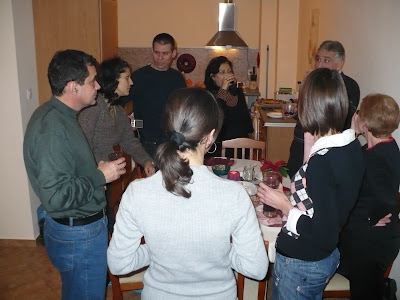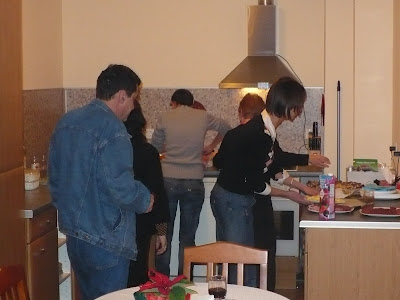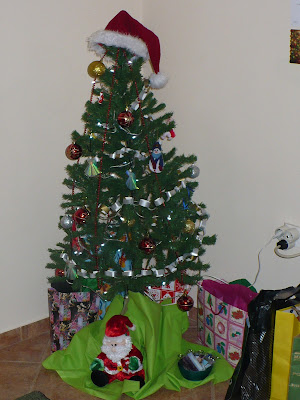What A Difference A Year Makes!
What a difference a year can make. Lynn and I are constantly surprised at what we can do in the second year of service, and how much our perspective, outlook, and impact has changed. This year, the holidays are a good example of this difference.
Last year, Thanksgiving was great. We had 13 volunteers with us, and it was just like being in the US. However, there was lots of stress trying to put it all together. We spent weeks looking for turkeys, and had several bad starts tying to make pumpkin pie, and other things. This year was a breeze. We really did very little planning for our 10 guests, and everything went smoothly. Knowing what we were dong meant we had more time to share Thanksgiving traditions with our Bulgarians friends this year. The way we did that was with food. We have learned sharing traditional foods (either Bulgarians sharing with us or us with them) is a great way to explain cultures. American pies can not be found here in Bulgaria. In fact, you will not even find standard pie plates. Their Tikva squash has the shape of a pumpkin, but is a dull gray color. However, the tikva is very sweet. We made “Tikva pies” for everyone during the Thanksgiving week. Monday was for my colleagues. Tuesday was the second pie for our Conversational English class. Thursday there was a Tikva and an apple pie for Lynn’s colleagues at school. We used the pies to explain the family Thanksgiving traditions, and they loved them. The only thing left were a few crimbs. There were many requests for recipes, but Lynn is not sure that even if the directions were written in Bulgarian, they would be able to make them without seeing one being made. Maybe some things are better left a mystery!!
Christmas this year will also be very different. Although Lynn or I have not purchased any gifts yet (we will get each other some small things next week), we have been very busy – in a good way. And… it will continue until we leave for Rome on December 27.
On December 10-11, our NGO had their annual meeting (and Holiday party). We had about 65 people attending the meetings, and the dinner. These are all Roma families we have helped, and the dinner was much more of a celebration than a dinner meeting. There was lots of music and dancing sprinkled in between plenty of homemade wine and rakia. But everyone was up and attending the meetings Saturday morning.

Immediately after the annual meeting concluded Saturday, Lynn and I were off to Na Gosti (visiting friends) with a person who has an office on the same floor where I work. Mimi and I have become close, and talk often. She has one son working on Cape Cod, and another daughter in College here. The day before going, Lynn and I got a lesson in making traditional Bulgarian holiday bread. It is called a “holiday Pitka” (roll). Actually it is large round bread, decorated with symbols of “good” things from Bulgaria. This includes strawberries, grapes, apples, birds, wheat, and other things. Our Tutor (Vessi) helped us make it. Mimi’s family was impressed, and it was really good. We combined the Bulgarian Pitka with their traditional Bulgarian dinner and one of Lynn’s American Apple Pies. The entire evening was wonderful.

Just before our Annual meeting, I started pushing to have a Holiday party for my colleagues. Last year, (in late January) we all went out to a small restaurant for dinner - - but that was all. I got people interested, and convinced them we should have it at someone’s home. Lynn and I actually wanted to do this at our place, and share more American Holiday traditions with our friends. So… this past Thursday evening, we had nine of us here in our small (but efficient) apartment/home. And it was GREAT! I had explained the concept of a “Yankee Swap” to all my colleagues. This was not easy because there is not even a good translation of the ward “swap” in Bulgarian. And then to get them to understand that you really don’t want to purchase a gift, just find something in your home which you don’t want and bring that as a gift was a challenge. Maria is living with her grandmother, and asked if she could swap her, and Ivan said he had an old cot that he wanted to get rid of. They got the idea! And – just like in the US - everyone had a great time giving (and taking) other peoples gifts.

Another wonderful part of this party was the preparation. Other than making Christmas cookies and another pie there was very little else for us to do. EVERYONE brought something. At one point almost everyone was working in our little kitchen. They were putting traditional Bulgarian Christmas eve foods into the oven to warm, cutting up appetizers, preparing breads, and pouring drinks. This is not generally the way we see things done when we Na gosti. When Lynn commented that it felt very American having everyone in her kitchen, we were told it is very normal among good friends. That was good to hear, and even better to watch! I think what was most exciting was to see all these people who we have come to care about deeply, relaxing and enjoying each other. They really don’t take or make time for themselves, and this seemed to be an exception. When we watched a bit of a video tape, what stood out was the laughter. It was 1:30 before the party ended. We had Bulgarian language tutoring Friday morning at 9AM. We were not as “sharp” as usual - - but it was worth it. Most importantly, I think my colleagues will do this again next year – even if we are not here to share with them.
This evening, we are going to a free concert at the large music high school in the old city section of Plovdiv. A girl’s choir will be performing, and we have been trying to get to one of their concerts for several months. They travel outside of Bulgaria, and are suppose to be very good. Going to Christmas concerts performed by students is something we have enjoyed doing for years now and it is so nice to keep a tradition like that alive while we are here. After we get back from that, we will be skyping into the Garrigus Christmas party in Massachusetts. With luck we will hook Scott into the call as well. Not the same as being together, but a great substitute. It will also be great to spend a few hours catching up with people we don’t normally have a chance to see.
This coming Tuesday evening, we will have a Christmas party with our conversational English class at the YMCA (where the classes are normally held). We did this last year, and had a wonderful time. This group of people has taught us so much about Bulgaria. I expect we will have 12-15 people attending. Wednesday evening is Lynn’s school Christmas Party. Last year, Lynn was sick, and we did not attend. We have been to other social events with them, and it is always fun. Thursday, Lynn, Petya, and I will go to a Christmas Concert with the Plovdiv Symphony. This will be the first time we have heard them. We have been told they are good, and I’m sure we will enjoy it.

Then it will be a quiet Christmas Eve here, and skyping with my family in Connecticut. We will try to get to a Christmas Eve service. Last year, the service times were not listed, (or maybe we just misunderstood) and we ended up attending on Christmas day. Then it will be packing up for our Rome trip. We have to be in Sofia December 26, because our flight on Monday is very early in the morning.
This year is so very different from last year. And it is much better! One of the few things that is the same about this Christmas and last is that we are not with family. Actually, this year we are spread out even more. Scott is in Iraq. We are in Bulgaria. Shawn and Chrissy are in NYC. Everyone else is in their home. But – everyone is safe and healthy – and those are really the most important things.
Lynn and I continue to be amazed by our experience with the Peace Corps. We have never questioned our decision to try this. It is very different from what we expected, and it is so much more. Our holiday wish to all of you is to Never ever give up on your dreams. Always be willing to take chances, and to step into unknown places. None of this is easy, but our experience says that it worth it – VERY worth it!
Have a Merry Christmas – and a Wonderful New Year!
Thanks for Reading – Keep Dreaming!
Mike














